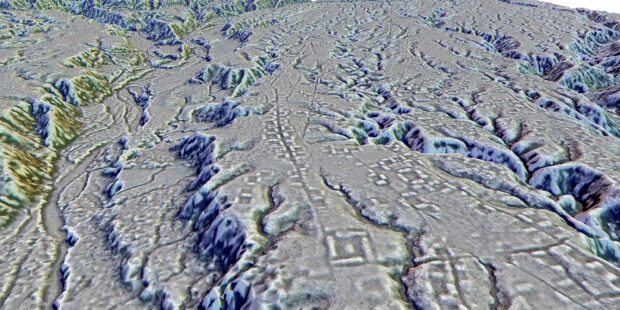Archeologists map lost cities in Ecuadorian Amazon

This LIDAR image provided by researchers in January 2024 shows complexes of rectangular platforms arranged around low squares and distributed along wide dug streets at the Kunguints site, Upano Valley, in Ecuador. Archeologists have uncovered a cluster of lost cities in the Amazon rainforest home to at least 10,000 farmers around 2,000 years ago, according to a paper published Thursday, January 11, 2024, in the journal Science. (Antoine Dorison, Stéphen Rostain via AP)
WASHINGTON — Archeologists have uncovered a cluster of lost cities in the Amazon rainforest that was home to at least 10,000 farmers around 2,000 years ago.
A series of earthen mounds and buried roads in Ecuador was first noticed more than two decades ago by archaeologist Stéphen Rostain. But at the time, ” I wasn’t sure how it all fit together,” said Rostain, one of the researchers who reported on Thursday’s finding in the journal Science.
Recent mapping by laser-sensor technology revealed those sites to be part of a dense network of settlements and connecting roadways tucked into the forested foothills of the Andes that lasted about 1,000 years.
“It was a lost valley of cities,” said Rostain, who directs investigations at France’s National Center for Scientific Research. “It’s incredible.”
The Upano people occupied the settlements between around 500 B.C. and 300 to 600 A.D. – a period roughly contemporaneous with the Roman Empire in Europe, the researchers found.
Article continues after this advertisementAgricultural fields with drainage canals surrounded residential and ceremonial buildings erected on over 6,000 earthen mounds. The most extensive roads were 33 feet (10 meters) wide and stretched 6 to 12 miles (10 to 20 kilometers).
Article continues after this advertisementREAD: Archaeologists in Peru find adolescent mummy wrapped in bundle
While it’s challenging to estimate populations, the site was home to at least 10,000 inhabitants – and perhaps as many as 15,000 or 30,000 at its peak, said archaeologist Antoine Dorison, a study co-author at the same French institute. That’s comparable to the estimated population of Roman-era London, then Britain’s largest city.
“This shows a very dense occupation and an extremely complicated society,” said University of Florida archeologist Michael Heckenberger, who was not involved in the study. “For the region, it’s really in a class of its own in terms of how early it is.”
José Iriarte, a University of Exeter archaeologist, said it would have required an elaborate system of organized labor to build the roads and thousands of earthen mounds.
“The Incas and Mayans built with stone, but people in Amazonia didn’t usually have stone available to build – they built with mud. It’s still an immense amount of labor,” said Iriarte, who had no role in the research.
READ: Archaeologists find 800-year old mummy in Peru
The Amazon is often considered a “pristine wilderness with only small groups of people. But recent discoveries have shown us how much more complex the past really is,” he said.
Scientists have recently also found evidence of intricate rainforest societies that predated European contact elsewhere in the Amazon, including Bolivia and Brazil.
“There’s always been an incredible diversity of people and settlements in the Amazon, not only one way to live,” said Rostain. “We’re just learning more about them.”